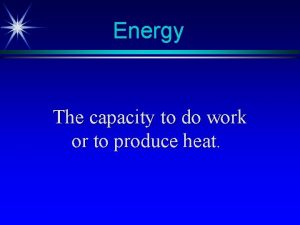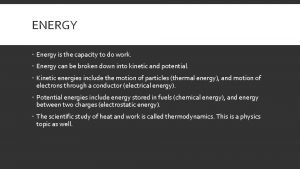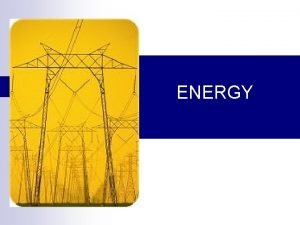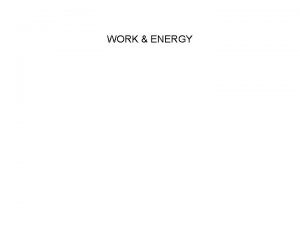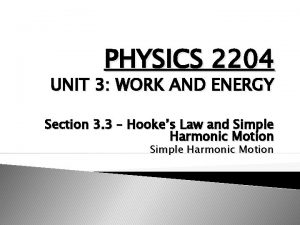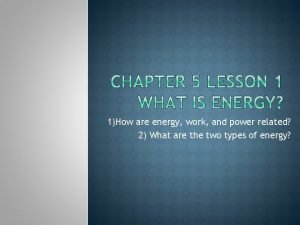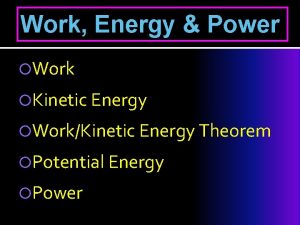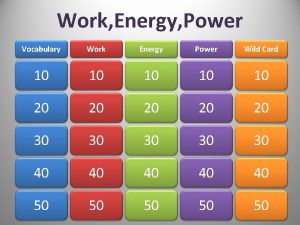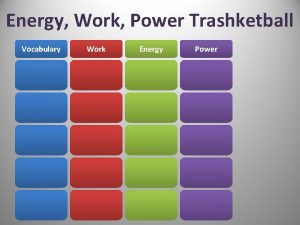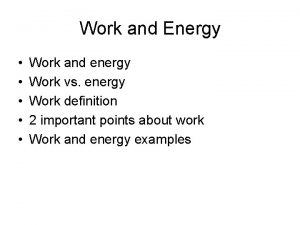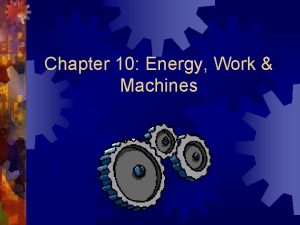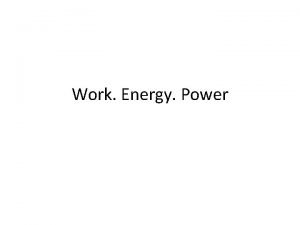Energy The capacity to do work Power The












- Slides: 12

Energy The capacity to do work. Power The rate at which work is done.

Energy The word energy originated from an Ancient Greek word that translates into “energeia. ” In contrast to the modern definition, energeia was a qualitative philosophical concept, broad enough to include ideas such as happiness and pleasure. Energeia possibly appears for the first time in the work of Aristotle in the 4 th century BC. 384 BC - 322 BC Aristotle was an ancient Greek philosopher and scientist. Along with Plato, he is considered the "Father of Western Philosophy".

Energy In the late 17 th century, Gottfried Leibniz proposed the idea of the Latin: vis viva, or living force, which defined as the product of the mass of an object and its velocity squared; he believed that total vis viva was conserved. July 1646 – November 14, 1716 Gottfried Wilhelm (von) Leibniz. was a prominent German polymath and philosopher in the history of mathematics and the history of philosophy. He became one of the most prolific inventors in the field of mechanical calculators. He also refined the binary number system, which is the foundation of all digital computers.

Energy In 1807, Thomas Young was possibly the first to use the term "energy" instead of vis viva, in its modern sense. Gustave-Gaspard Coriolis described "kinetic energy" in 1829 in its modern sense, and in 1853, William Rankine coined the term "potential energy". It was argued for some years whether heat was a physical substance, dubbed the caloric, or merely a physical quantity, such as momentum. In 1845 James Prescott Joule discovered the link between mechanical work and the generation of heat. Thomas Young was possibly the first to use the term "energy" in the modern sense.

Law of Conservation of Energy These developments led to theory of conservation of energy, formalized largely by William Thomson (Lord Kelvin). In physics, the law of conservation of energy states that the total energy of an isolated system remains constant, it is said to be conserved over time. This law means that energy can neither be created nor destroyed; rather, it can only be transformed or transferred from one form to another. June 26, 1824 - December 17, 1907 William Thomson did important work in the mathematical analysis of electricity and formulation of the first and second laws of thermodynamics, and did much to unify the emerging discipline of physics in its modern form.

First Law of Thermodynamics The first law of thermodynamics is a version of the law of conservation of energy. The First Law of Thermodynamics states that energy can never be created or destroyed. Since we can’t make energy. . we have to transform energy from one kind to another.

Forms of Energy The total energy of a system can be subdivided and classified into potential energy, kinetic energy, or combinations of the two in various ways. Photo credit: Brainly. in Potential Energy Kinetic energy is determined by the movement of an object. Potential energy reflects the potential of an object to have motion. Photo credit: Tutorvista

Forms of Energy Electrical energy is energy derived from electric potential energy or kinetic energy. "Electrical energy" is energy that has been converted from electric potential energy to another type of energy, heat and light. This energy is supplied by the combination of electric current and electric potential that is delivered by the circuit. At the point that this electric potential energy has been converted to another type of energy, it ceases to be electric potential energy. Electricity Light + Heat Electricity Motion + Heat

Units of Energy Joule - the SI derived unit of energy. It is also the energy dissipated as heat when an electric current of one ampere passes through a resistance of one ohm for one second. An electric current is a flow of electrical charge. December 24, 1818 - October 11, 1889 James Prescott Joule was an English physicist, mathematician and brewer. Joule studied the nature of heat, and discovered its relationship to mechanical work. This led to the law of conservation of energy, which in turn led to the development of the first law of thermodynamics.

Units of Energy The three most basic units in electricity are: voltage (V), measured in volts current (I, uppercase "i"), measured in amps resistance ®, measured in ohms. Ohm's law says that the current is equal to the voltage divided by the resistance or I = V/R. March 16, 1789 - July 6, 1854 Georg Simon Ohm was a German physicist and mathematician. Ohm found that there is a direct proportionality between the potential difference (voltage) applied across a conductor and the resultant electric current.

Units of Energy Electrical power is measured in watts. In an electrical system power (P) is equal to the voltage multiplied by the current. P=Vx. I This means that you can increase the power (the rate at which electricity is used) by increasing the voltage and /or increasing the current. 1 watt = 1 joule per second January 19, 1736 - August 25, 1819 James Watt was a Scottish inventor, mechanical engineer, and chemist who improved on the Newcomen steam engine with his Watt steam engine, which was fundamental to the changes brought by the Industrial Revolution. He developed the concept of horsepower.

Resources: https: //science. howstuffworks. com/environmental/energy/question 501. htm https: //www. reference. com/science/many-watts-60 -hz-eb 880576214 f 7 ec Wikipedia. com https: //www. reference. com/science/many-watts-60 -hz-eb 880576214 f 7 ec
 Energy is the capacity to do work
Energy is the capacity to do work Energy is the capacity to do work
Energy is the capacity to do work Energy is the capacity to do work
Energy is the capacity to do work Energy is the capacity to do work.
Energy is the capacity to do work. Production units have an optimal rate of output where
Production units have an optimal rate of output where Real power formula
Real power formula 0kei0
0kei0 Work, power and energy activities
Work, power and energy activities Joule units
Joule units Physics 2204 unit 3: work, power, energy
Physics 2204 unit 3: work, power, energy Definition of work power and energy
Definition of work power and energy How are work and power related
How are work and power related Work power energy and machines
Work power energy and machines

